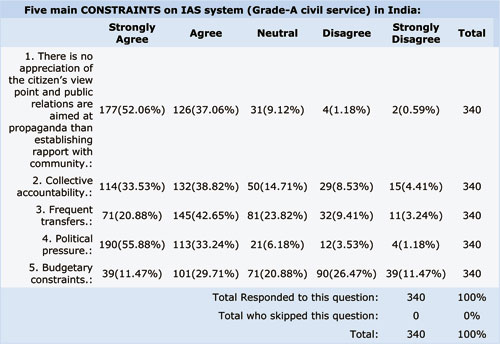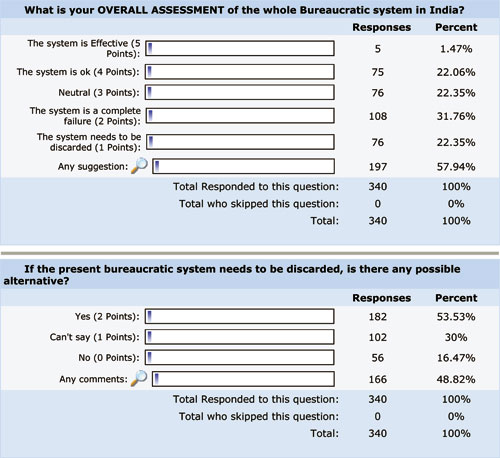|
A survey on the Indian bureaucracy by two Indian academics in the Gulf was carried out to ascertain how the public views the present day Indian bureaucratic system. Interestingly, while the perception has been that the bureaucracy has often had to serve its political masters, and not the public interest for which it was set up, there is also a view that the same system has been able to deliver, and has facilitated through policy implementation the second highest growth rate for any country in the world.
Those that participated in the three-month online survey on the Indian bureaucratic system included retired persons, Government officials, business owners, corporate executives, doctors, engineers, social workers, journalists, academicians and students. A judgmental sampling technique was used in which emails were sent out to 2,500 individuals with a request to participate in this survey. A total of 340 individuals responded to online questionnaires, making a 13.6% response rate. The format of the survey instrument and scorecards used in the questionnaire were reviewed by several experts on the subject. Of the respondents, 84 per cent were resident Indian nationals, the rest (16 per cent) were NRIs from 13 countries. About 59 per cent of the respondents were over 50 years, and, therefore, had better recall experiences with the system than their younger counterparts.

About 93% of the survey respondents stated that they had dealt with the government system for various services like certificates related to marriages and death, passport, police services, and other miscellaneous services. About 46% of the respondents were not satisfied with the services provided to them by the system and more than 25% had bad experiences with the system. Only 13.2% considered the system to be ok. An overwhelming majority—98 per cent—say that they have an interest in Indian Administrative Bureaucratic System.

The survey was bifurcated into two—the IAS system (group A civil system) and the lower-level bureaucratic system.
|
Furthermore, 89% of the respondents held the view that the reward system is basically skewed towards the corrupt officers who get prime postings while the honest officers often get punishment transfers. About 85% of the respondents who took part in the survey agreed that the IAS system encourages only generalists and not specialists |
Major Highlights
IAS System (Group A Civil System)
a) Strengths and positive aspects
One of the highlights of the survey was that about 79% of respondents believe that IAS system has the power to take decisions which directly affect people. Approximately 81% of the respondents felt that “there exists decent living and working conditions for the IAS officers”. Similarly, over 72% of the respondents felt that there is enough scope for promotion and new challenges for the profession. As high as 67.4% of the participants in the survey believe that the system is still capable of attracting good talent into the cadre through its strong recruitment process.
b) Weaknesses and Negative aspects
An overwhelming 93.5% of those surveyed were of the opinion that in the IAS system the tendency is to serve political masters more than the public. In public perception, this sounds like some kind of understanding between the two which may be susceptible to misuse of the system as the bureaucrats may dutifully protect the interests of politicians. This finding really suggests the need for taking a close look on this issue by the policy makers and administrative reformers. Similarly, approximately 92% of the respondents are of the view that the over-insured job security has made the IAS officers generally less caring. In spite of this, the IAS officers are so entrenched that they advance smoothly to senior positions.

Furthermore, 89% of the respondents held the view that the reward system is basically skewed towards the corrupt officers who get prime postings while the honest officers often get punishment transfers. About 85% of the respondents who took part in the survey agreed that the IAS system encourages only generalists and not specialists. This finding calls for introduction of a lateral recruitment process into the system in order to enhance professionalism and make it more efficient and effective. It is widely held that there are three types of activities involved in the system viz. (1) transaction analysis, (2) strategic analysis, and (3) strategic planning. In order to enhance (2) and (3), lateral entry into the system is a must particularly when recruiting officers into the technical departments of the Government.
c) Main Constraints
Over 90% of the survey respondents felt that political pressure is the major constraint of the Civil Service system. Interestingly, 89% of the respondents also hold the view that there is no appreciation of the citizen’s viewpoint and public relations are aimed at mere propaganda rather than establishing rapport with the community.
Lower level Bureaucratic System
a) Strengths and Positive Aspects
A vast majority of the participants (77%) believe that one of the positive aspects with respect to the lower level bureaucratic system is excessive dependence of senior officers on the junior level bureaucrats. Approximately 62% of those surveyed agreed that lower level bureaucratic system constitutes an integrated and inseparable part of the governing system. Furthermore, 47.6% considered proper documentation and creating memory banks of decisions as one of the positive aspects of the system.
b) Weaknesses and Negative Aspects
A vast majority (93%) of those surveyed felt that the lower level bureaucrats had no sense of proper utilization of public money and the work is not done in an efficient and timely manner. This is a serious issue and a clear indication of the existence of a cult for wasteful expenditure and non-existence of cost consciousness in the system. Almost 92% of respondents also agree that the lower bureaucratic level in India is insensitive and hostile in attitude while serving the poorest sections of society. Approximately 91% of the respondents also believe that the system encourages a culture of connections (Vasta or Jaan
Pehchaan culture).
Another key weakness of the lower bureaucracy highlighted by 91% of the respondents is that promotions are based on seniority rather than merit and there is a dearth of performance-oriented motivations or even incentives.

c) Main constraints
About 79% of the respondents cited political intervention as one of the major constraints with respect to the lower level bureaucracy while 70% cited “fewer opportunities for professional growth” as another major constraint on the lower bureaucratic system.
Analysis and interpretations of Survey based on public perception.
Over 54 % of the total respondents feel that the system is a complete failure. A reasonable majority (54%) held the view that there can be an alternative to the present system and only about 16% said “no”.
The respondents were concerned with the degree and extent of corruption prevailing in the system. It was suggested that there should be an effective vigilance mechanism to root out the practice of corruption. A strong judicial system is required to meet the challenges. Promotions and transfers ought to be outside the powers and purview of politicians. The transfers should take place invariably, intra ministry / department and not inter ministry / department.
Many of the respondents suggested that lateral entry in the system will bring in more professionalism. It was suggested that lateral recruitment will strengthen the system with specialists. Entry to the IAS should be lateral from all other Indian services including defence-cadres on merit through competition. One of the respondents stated the following:
“There must be a system of induction of fresh, professionally competent and eminent people from other walks of life into the various ministries at the level of Joint secretaries along with the very competent, selected IAS officers with integrity. This joint cadre should man the positions from Joint Secretary upwards to take policy decisions and take care of governance at the highest rung. Governance at the highest level should not be the prerogative of the IAS cadre alone. They must compete with others at Joint Secretary Level and above”.
As conceived by ex- prime minister late Rajiv Gandhi professionals should be recruited to administrative positions rather than generalists. It is argued that though there is no assurance that any professional will be less corrupt yet empirical results suggest that professionals deliver better results and also show a deeper understanding of the system. Respondents suggested that highly skilled and experienced professionals must head the ministries both at the political and bureaucratic levels. In this regard, one respondent argued that Manmohan Singh as Finance Minister with Montek Singh Ahluwalia as finance secretary together did a wonderful job for the country.
|